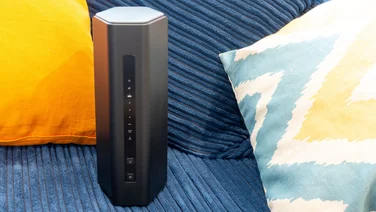To help us provide you with free impartial advice, we may earn a commission if you buy through links on our site. Learn more



















- Very fast over Wi-Fi 6
- Huge range of features included in the price
- USB and 2.5GbE connections
- Plenty of cheaper options
- Only one multi-gigabit Ethernet port
Synology is better known for NAS (network attached storage) systems than routers, but its networking products deserve more attention. The RT6600ax is a terrific Wi-Fi 6 router, with fantastic performance and arguably the best management interface in the business.
It does have some limitations. The price is steep, especially since there’s no support for Wi-Fi 6E, though performance over regular Wi-Fi 6 is so good that that hardly matters. And while 2.5GbE is supported, you only get a single socket; for the price you might expect a bit more versatility.
Overall, though, the RT6600ax is a cut above the competition. If you’re willing to pay a premium for a fast router that’s a joy to manage, it’s a very strong contender.
Synology RT6600ax router review: What you need to know
The RT6600ax has an unusual Wi-Fi setup. Alongside the standard 2.4GHz radio, it has not one but two 5GHz transmitters – a regular 2×2 MIMO unit with a maximum link speed of 1.2Gbits/sec, and a high-performance radio that supports 4×4 MIMO and goes up to 4.8Gbits/sec. This tri-band arrangement goes some way toward explaining the high price.As well as supporting the standard Wi-Fi 6 channels, the high-speed radio can also operate in the 5.9GHz frequency range; this isn’t accessible to most client devices, but it can be used for a high-bandwidth, low-interference backhaul connection if you wish to pair multiple Synology routers or mesh units together.
There’s no 6GHz transmitter, however, so Wi-Fi 6E is out of the question, nor does the RT6600ax know about Wi-Fi 7. You can still use it with devices that support these technologies, but you won’t get the benefit of their higher frequencies and speeds.
The other distinctive selling point of the RT6600ax is its SRM (Synology Router Manager) operating system. This uses a smart mouse-driven GUI that feels more like a Linux desktop than a typical router interface, and it offers an extensive range of features and options. If you’re looking for a router to set up and forget about then this might not be much of a draw, but if you like to get hands-on with your network settings it’s a definite plus point.
READ NEXT: The best wireless routers
Synology RT6600ax router review: Price and competition
At £317, the RT6600ax is expensive. If you don’t need extreme wireless speeds or a sophisticated management interface, there are plenty of cheaper options.
For example, the Linksys MR7350 will provide decent Wi-Fi performance throughout a typical-sized home for just £95. Budget a little more and you can get our recommended Asus RT-AX59U for a reasonable £123; its Wi-Fi speeds at long range aren’t quite a match for the Linksys, but it comes with a great set of software features, including built-in network security and parental controls.
Two other router options from Asus worth considering are the Asus TUF Gaming AX5400 and the Asus RT-AXE7800. The former has a selection of custom gaming features to help you get a smooth, fast online experience, while the latter adds Wi-Fi 6E, enabling top-speed connections for 6GHz-enabled devices. These models cost £166 and £225 respectively, so they’re still substantially cheaper than the Synology RT6600ax.



















The RT6600ax’s most direct competitor, price-wise, is the Netgear Nighthawk RAXE300, which achieved some of the fastest download speeds we’ve seen on the 6GHz band. However, the Netgear’s software features are more limited than the Synology’s, and security and parental controls cost extra, which is a bit of a cheek when the router itself costs £350.
Beyond that, Netgear’s flagship Nighthawk RAXE500 is faster still, but at £550 it’s hard to recommend. If you’re looking for maximum future-proofing, the Netgear Nighthawk RS700S adds the latest Wi-Fi 7 technologies into the mix, but costs an enormous £800. To be honest, we’d be inclined to hold fire on Wi-Fi 7 until it has mainstream support, which could well mean 2025 or beyond.
Synology RT6600ax router review: Design and features
The RT6600ax has a plain, functional design and is surprisingly large, with a footprint of 320mm x 200mm, not including the six antennas stuck around the edges. Wired connectivity is covered by three gigabit Ethernet LAN ports at the rear, plus a 2.5GbE port that can be used for either a multi-gig internet connection or high-speed local networking. Note that, since there’s only one socket, you can’t make two wired devices talk to each other through the router at 2.5Gbits/sec unless you invest in an external switch.



















The Synology RT6600ax also has a single USB-A socket, which will take either an external storage device or a 4G/5G mobile adapter to serve as a secondary internet connection. It supports a maximum speed of 5Gbits/sec, or you can slow it down to around 1Gbit/sec to minimise interference on the 2.4GHz Wi-Fi band – a thoughtful feature that we haven’t seen elsewhere.



















Router management is handled via the browser-based SRM interface. This works very similarly to the DSM platform found on the company’s NAS devices, with a column of desktop icons that open up panels for controlling and monitoring different aspects of the router’s operation. To be honest I found it all a bit overwhelming at first: each panel has multiple pages, most of which further divide into multiple tabs, so while the layout is pretty logical, it can take a fair bit of clicking around to learn which settings are on offer and where they’re located.
Still, I can’t complain about the range of graphs, dashboards and controls available. In the Network Center you can browse and monitor traffic and hardware statistics, configure your internet connection and LAN topology, apply bandwidth limits to individual clients and optionally route your traffic via a third-party VPN.



















The Wi-Fi Connect panel lets you explore and tweak your Wi-Fi settings, including the option of broadcasting a single network name or splitting the two 5GHz networks into separate SSIDs. If you have multiple Synology routers, you can combine them here into a mesh network.
Then there’s Safe Access, which manages the router’s built-in security features, such as blocking dangerous online content and applying child-friendly web filters and time limits to specific devices. The Control Panel lets you restrict access to the router itself, and configure sharing settings for USB storage.



















Additional functions can be installed from the Synology Package Center; this isn’t exactly packed with apps, but it offers a free malware scanner, an automatic file download agent and servers for inbound VPN, DNS, RADIUS and Synology’s DLNA-compliant media streaming component.
As I’ve mentioned, it’s a lot to take in, but if you want to find something specific you can use the search function to jump directly to pages containing a given keyword. Or you can turn to Synology’s DS Router mobile app, which provides a simpler, menu-driven interface to the most useful and frequently needed features.



















And it’s very pleasing to note that this whole breadth of features is included in the price, with no tacked-on subscription fees – another point that helps justify the high purchase price.
READ NEXT: The best mesh Wi-Fi routers
Synology RT6600ax router review: Performance
I tested the RT6600ax’s performance by setting it up in the study at the front of my home, with an Asustor Drivestor AS3304T NAS appliance connected to the 2.5GbE socket.
I then connected my test laptop – which has an Intel AX210 2×2 MIMO Wi-Fi 6E network card – to each of the RT6600ax’s 5GHz networks in turn, carried it to various locations in the house and measured the average upload and download speeds when copying a set of 100MB test files to and from the NAS.
Here are the speeds I saw, with results from other aforementioned routers for comparison:


The primary Wi-Fi radio in the RT6600ax put in a magnificent performance, racing well ahead of cheaper Wi-Fi 6 routers. It also provided very strong coverage even at the far end of my home: in most locations it was actually faster than rival routers using Wi-Fi 6E.
That’s great news, because it means even older devices that don’t support 6GHz Wi-Fi can still get excellent speeds from this router. And because the RT6600ax supports 4×4 MIMO, you can expect this type of blazing performance even when two laptops are using the connection at once.
The secondary 5GHz radio isn’t anywhere near as fast as the main one – which is hardly surprising, as you’ll recall that it’s only rated for a quarter of the speed. Even so, there’s still a usable chunk of bandwidth here: you could happily run your smart TVs, phones and iPads off this network, while reserving the faster connection for laptops and gaming consoles. That makes the RT6600ax a good choice for a flexible one-box, whole-home Wi-Fi solution.



















One thing to mention is that running twin 5GHz radios seems to push up the power requirements: the Synology RT6600ax drew around 15.3W when sitting idle, jumping up to a peak of 21.1W during my file-copy tests.
Synology RT6600ax router review: Verdict
The RT6600ax is one of the most feature-packed routers we’ve tested. It might not quite match the breadth and depth of technical control offered by Asus’ router firmware, but there’s still a huge amount of administrative control here, and its graphical UI has a more professional feel.
Be under no illusions: this is a large, power-hungry and expensive router. Most homes will do just fine with the Asus RT-AX59U – or you could go for the Wi-Fi 6E-enabled RT-AXE7800 and still save around £70 versus the Synology.
However, based on the RT6600ax’s test results over plain old Wi-Fi 6, we can’t say that 6E support is much of an advantage. Indeed, if you’re using a mixture of Wi-Fi 6 and 6E devices, the Synology’s twin 5GHz radios give you more options for managing bandwidth across your whole network. Factor in the uniquely slick front-end and it’s a very attractive router – not a budget option, but a compelling choice for those with money to spend.







